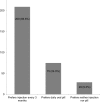Willingness of community-recruited men who have sex with men in Washington, DC to use long-acting injectable HIV pre-exposure prophylaxis
- PMID: 28827821
- PMCID: PMC5565177
- DOI: 10.1371/journal.pone.0183521
Willingness of community-recruited men who have sex with men in Washington, DC to use long-acting injectable HIV pre-exposure prophylaxis
Abstract
Objectives: Clinical trials are currently investigating the safety and efficacy of long-acting injectable (LAI) agents as HIV pre-exposure prophylaxis (PrEP). Using National HIV Behavioral Surveillance data, we assessed the self-reported willingness of men who have sex with men (MSM) to use LAI PrEP and their preference for LAI versus daily oral PrEP.
Methods: In 2014, venue-based sampling was used to recruit MSM aged ≥18 years in Washington, DC. Participants completed an interviewer-administered survey followed by voluntary HIV testing. This analysis included MSM who self-reported negative/unknown HIV status at study entry. Correlates of being "very likely" to use LAI PrEP and preferring it to daily oral PrEP were identified using multivariable logistic regression.
Results: Of 314 participants who self-reported negative/unknown HIV status, 50% were <30 years old, 41% were non-Hispanic Black, 37% were non-Hispanic White, and 14% were Hispanic. If LAI PrEP were offered for free or covered by health insurance, 62% were very likely, 25% were somewhat likely, and 12% were unlikely to use it. Regarding preferred PrEP modality, 67% chose LAI PrEP, 24% chose oral PrEP, and 9% chose neither. Correlates of being very likely versus somewhat likely/unlikely to use LAI PrEP included age <30 years (aOR 1.64; 95% CI 1.00-2.68), reporting ≥6 (vs. 1) sex partners in the last year (aOR 2.60; 95% CI 1.22-5.53), previous oral PrEP use (aOR 3.67; 95% CI 1.20-11.24), and being newly identified as HIV-infected during study testing (aOR 4.83; 95% CI 1.03-22.67). Black (vs. White) men (aOR 0.48; 95% CI 0.24-0.96) and men with an income of <$20,000 (vs. ≥$75,000; aOR 0.37; 95% CI 0.15-0.93) were less likely to prefer LAI to oral PrEP.
Conclusions: If LAI PrEP were found to be efficacious, its addition to the HIV prevention toolkit could facilitate more complete PrEP coverage among MSM at risk for HIV.
Conflict of interest statement
Figures


References
-
- Centers for Disease Control and Prevention. Diagnoses of HIV infection and AIDS in the United States and dependent areas, 2015. HIV Surveill Rep. 2016; 27: 1–114. http://www.cdc.gov/hiv/library/reports/hiv-surveillance.html.
-
- Grant RM, Lama JR, Anderson PL, McMahan V, Liu AY, Vargas L, et al. Preexposure chemoprophylaxis for HIV prevention in men who have sex with men. N Engl J Med. 2010; 363: 2587–2599. doi: 10.1056/NEJMoa1011205 - DOI - PMC - PubMed
-
- Centers for Disease Control and Prevention. Preexposure prophylaxis for the prevention of HIV infection in the United States– 2014 clinical practice guideline. 2014. https://www.cdc.gov/hiv/pdf/prepguidelines2014.pdf.
-
- Van der Straten A, Van Damme L, Haberer JE, Bangsberg DR. Unraveling the divergent results of pre-exposure prophylaxis trials for HIV prevention. AIDS. 2012; 26: F13–F19. doi: 10.1097/QAD.0b013e3283522272 - DOI - PubMed
-
- Golub SA, Gamarel KE, Rendina HJ, Surace A, Lelutiu-Weinberger CL. From efficacy to effectiveness: facilitators and barriers to PrEP acceptability and motivations for adherence among MSM and transgender women in New York City. AIDS Patient Care STDS. 2013; 27: 248–254. doi: 10.1089/apc.2012.0419 - DOI - PMC - PubMed
MeSH terms
Substances
Grants and funding
LinkOut - more resources
Full Text Sources
Other Literature Sources
Medical
Miscellaneous

